
The CREP (Conservation Reserve Enhancement Program) provides the landowner an exceptional opportunity to perform improvements that would otherwise be too long term or insufficient in the benefits column to warrant performing. In a nutshell CREP provides :
- Cost sharing for measures ranging from 50% to 90% of scheduled rates,
- Annual revenue from $75 to $100 per acre,
- Support and commitment periods from 10 to 15 years,
- it does not last forever (unlike greenways or environmental easements),
- it provides for a host of strategic improvements that are almost free to the landowner,
- it provides a reasonable annual revenue from a reliable source (USDA),
- the program is administered with considerable sensitivity to the landowner,
- it is reversible - if you really want out just nullify the contract and return the funds (review their terms carefully),
- it has a tremendous social benefit (if our watershed lands were properly protected all water bodies (lakes, rivers, streams, bays, and estuaries) would be greatly improved.
CREP is like any other opportunity - it only lasts so long. Many of its cousins are annually renewed and have become legislative favorites. CRP (Conservation Reserve Program) from which the CREP was derived is such a program. Other programs include EQIP (Environment Quality Improvement Program), FIP (Forestry Incentive Program), WRP (Wetland Reserve Program), WHIP (Wildlife Habitat Incentive Program), PFW (Partners for Wildlife), and others. All of these programs have cost share support. Many are serviced on a first-come-first-served basis and are discontinued when the funding is committed. The specific operations that are supported will also vary from year to year due to the special issues that may prevail. In the northeast it may be ice damage salvage cutting and forest improvements. After drought conditions and wildfires it may be fire abatement measures (fire trails, control burns, fuel load reduction measures, …). The point is these are all tools available for the land manager to enhance the total return, 'maximize value' from the land unit. Strategic locations of fire lanes can be future roadways into remote units, dramatically reducing the cost of providing those roads. Water facilities provided under CREP can improve animal health and weight gain rates. They can also reduce mortality rates due to animal losses in bogs. Those same watering facilities can provide gravity fed irrigation if positioned strategically. There are some extremely informative web sites provided on CREP. You need only perform a search (Google, Yahoo) on CREP (provide "must include" of "conservation" "environment" to avoid other sites with the same acronym). Here are some particularly useful sites :
| Description | URL or Web Address |
| Official USDA CREP site | http://www.fsa.usda.gov/dafp/cepd/crep.htm |
| List of Cost Share Programs in VA | http://www.dof.virginia.gov/mgt/cip-summary.shtml |
| USDA Conservation Programs | http://www.fsa.usda.gov/dafp/cepd/default.htm |
| VA CREP Summary | http://www.fsa.usda.gov/pas/publications/facts/crepva00.pdf |
| WV CREP Summary | http://www.fsa.usda.gov/pas/publications/facts/html/crepwv02.htm |
| PA CREP Summary | http://www.fsa.usda.gov/pas/publications/facts/creppa00.pdf |
| MD CREP Summary | http://www.fsa.usda.gov/pas/publications/facts/html/mdcrep.htm |
| NC CREP Summary | http://www.fsa.usda.gov/pas/publications/facts/html/nccrep.htm |
| DE CREP Summary | http://www.fsa.usda.gov/pas/publications/facts/html/crepdel99.htm |
Virtually
all of our reforestation efforts in the US and Central America have been
through the use of residual trees in the harvest areas and other selective
harvesting. Planting has only been used to reclaim units where no desirable
seeders were available. All planting until CREP was performed with bare
seedlings. That is, seedlings were planted without any supplemental accommodations.
The CREP programs of the late 90's and early 2000 have all mandated the
use of "tree tubes" or "growth tubes" and a "mulch
mat". The idea of these supplemental accommodations is to improve
the survivability of the planting and growth rate to ensure meeting the
objectives of the CREP program. We were skeptics. On the surface this
looked like another $700 hammer from the federal government. Being learned
professionals in the field, we researched the issue at hand. We needed
compelling empirical evidence in order to be party to this kind of expenditure.
We also needed a better understanding from the "plant perspective".
We found compelling research results that indicated 400 to 600 percent
faster growth rates can be expected in the first 1 to 4 years! Survival
rates of 90 to 95% with tubes can be expected as compared to 60 to 75%
without tubes (see Growth Tube References).
Since our CREP plantings to-date have focused on mast production, we found
big value in the increased growth rate. We are experiencing nut production
within 3 to 5 years as opposed to 5 to 10 years. We also learned a few
very valuable lessons along the way. These are summarized later.
The Growth Tube is basically a growth chamber for the plant. Ideally,
it protects the plant against every possible growth deterrent and health
hazard that the world provides and facilitates health and expeditious
growth in every possible manner. This is a big calling, but if you are
going to bring in the guys in the white lab coats and invest in their
solution then let's get the job done all the way. From a "plant's
perspective" the tube takes care of some big issues :
- Physically protects the plant from browsing, insect infestation, hail, winds, excessive sun, mowing, herbicide, and desiccation (drying out). These alone are very big issues, especially where white tail deer are abundant, summer storms produce winds in excess of 40 miles per hour with driving rains and hail, and daytime temperatures reach 95 F and above.
- Provides condensation capture with moisture condensing on the tube surface providing heightened humidity and water. This helps keep the leaf well hydrated, essential for accelerated growth.
- Selective solar radiation transmission and reflection, transmitting into the tube wavelengths of light that are photosynthetically active and reflecting long wavelengths that increase tissue temperatures. I know this sounds kind of hi-sci but this is a real and significant factor for plant health and development. Imagine what would happen if the tube failed in this area! - a pale and growthless plant that looked like it had been put in a microwave!
All is not wonderful in the use of growth tubes (and mulch mats). They have their draw backs :
- Expensive to buy - 4 foot tubes can cost from $1.85 to $3.20 at the time of this writing (06/2004). The actual trees may cost less than 20% the cost of the tubes!!
- Tubes require stakes - they must be rot resistant, non-toxic to the seedling, and sturdy. Expect to pay from $0.80 to $1.75 for oak stakes (1"x1"x48" sharpened).
- Bulky to handle - planting crews can only carry from 100 to 200 tubes per person and this depends on the tube and packaging. The stakes have to be transported as well.
- Time consuming to install - the tube takes longer to install than planting the tree. Figure on 1 minute if the supplies are on the ground already - pound the stake, position the tube, fasten the tube. Figure on another half minute for the mulch mat - position the mat, push the 4 staples.
- Unsightly - we make sure landowners view a newly planted site and an aged site (year 2 to 3), so they know what to expect. I've been asked if CREP has a cemetery land-use rider. The installed tubes look a bit like grave site markers. The reality is that you cannot see the mulch mats if there is a true need for them - surface vegetation is above 18 inches. The tubes take some getting used to. They have great aesthetic appeal after about 10 weeks if you go around and look down the tube. You see this vibrant vegetative growth racing to the top of the tube. The terminal meristem (growth tip) is healthier than you've ever seen them under natural conditions and by week 12 (3 months of growth) some of those 10 and 18 inch bare root seedlings are showing foliage above the end of the 4 foot tube!! Now the tube takes on an aura of beauty when viewed.
- They require attention - wind storms will blow them down or "weather vane" the tube over the seedling, remove much mats. Animals (deer and livestock) knock tubes over and even drag off mulch mats. Tubes should be removed and collected after they have served their purpose (after 3 to 4 years).
With all
of the pro's and con's taken into consideration our professional and objective
assessment can be summarized simply, "if you are planting a seedling
to produce a tree use a tube". If you are planting for some other
purpose, the tube may be optional. In fact, we are so convinced about
the use of growth tubes that we are now a distributor for the "Miracle
Tube" and "Tree Pro" tubes. We are also very supportive
of the CREP program (in its current composition 6/2004). We are presently
providing a 30% discount on all tubes used for all CREP program plantings
in Virginia, Maryland, West Virginia, North Carolina, and Pennsylvania
(see Tube Prices). If your CREP planting
is in another state you may contact us anyway and we will match you up
with a tube provider who will provide a high level of support for the
CREP program. If your CREP planting involves more than 4,000 trees please
contact us, as we may be able to provide some additional discount. We
can also provide solid oak stakes at the lowest prices possible. If after
purchasing our stakes you find lower prices on clear oak stakes we will
refund the difference plus 5%. If you are planting under any other program
of watershed protection in the Chesapeake Bay watershed we will apply
the same commitment as to the CREP.
You might note that we manage lands in Central America as well. The cost
of labor, land, and seedling, length of growing season and conditions
favorable to plant growth and other factors mitigate the absence of the
tube. Presently we do not use growth tubes on any lands in Central America.
We might think differently about this if the plant species, its problems,
and economics were different.
Lessons learned with growth tubes and plantings in general:
- The most successful plantings involve planning and timing. Plan everything well in advance (we use Microsoft Project and a detailed check list). Time the planting to occur after the ground has thawed, after the period of continued freezing temperatures and heavy snows, during periods while the ground is still very wet, and well (at least 3 weeks) before the leaf-out of your earliest tree species. Try driving an Oast bar into dry ground of heavy soils to plant 1000 trees only once to become convinced of this. Your planting and stake driving will go much, much faster if the ground is wet for heavy, low sand soils. The effort will be less fatiguing as well.
- If you are planting in an area with dense and vigorous ground cover, apply a killing dose of herbicide to the 3'x3' areas in which the seedlings will be planted. Apply in the fall prior to the spring plant. This will make the mulch mat more effective and faster to apply. Also you will have fewer mats removed by high winds, as the mat lies flatter to the ground. If one person plants and another tubes, it will be easier to find the seedling in the middle of a brown zone.
- Purchase tree seedlings from quality and reputable nurseries in the same zone of the planting, order as early as you can (to ensure availability and the better specimen tend to be used in early orders). We made the mistake of ordering black walnut from a nursery only one zone north of the planting. They had snows and freezing rains that hindered getting the trees to us before the start of our local leaf-out. Survivor rates were the lowest in black walnut over all other species and the black walnut were planted the day after they arrived and looked like well nurtured seedlings.
- Plant as soon after receiving the seedlings as possible and store at temperatures of 40 F +/- 5 degrees. We have planted as soon as the day after delivery and no later than 10 days after delivery. Plant vigor and survivability will be highest the sooner they are planted.
- Unpack seedlings at time of planting. Good nurseries do an excellent job of moistening the roots and applying materials to retain the moisture and permit sufficient aeration of the roots. Removing this material to "check on seedling condition" will invariably diminish their vigor.
- If possible plant on overcast or light rain days. No tube yet invented will secure high plant vigor and survivor rates that result from improper handling of the seedlings. Keep the roots moist but never submersed in water. Keep them shaded and never exposed to direct sunlight. Remove them from the transport container and place them directly in the planting hole. Never lay them on the ground with roots exposed while you perform some operation.
- Drive the stake in the ground until it is very secure - at least 6 or 8 inches in heavy soil, 12 inches for lighter soils. In areas of very high winds (excess of 40 mph) 2 stakes are preferred - one on each side of the tube.
- Place the stake at a distance from the seedling equal to the radius of the tube - one half the diameter. This will center the seedling stem in the tube. Place the stake so a flat surface of the stake faces the seedling. This will reduce the tendency of the tube to settle in a position where the seedling is not centered in the tube. Fasten the tube securely and tightly to the stake. In areas of high winds the tube will have a natural tendency to "weather vane" on the stake - that is it will rotate on the stake to be down wind of the stake. This may result in the tube being pushed over the seedling, thwarting growth instead of promoting it.
- Place the mulch mat so that it lies flat on the ground, not elevated by vegetation underneath it. If you are going to apply any lime, fertilizer or other treatment, do so before placing the mat. Fold the corners of the mat back under the staples to provide a better hold on the mat and less tendency to tear under force of winds.
- Use a field proven tube (either Tree Pro, Miracle Tube, or Tubex) and be sure that they provide "releasable ties" (see the image). These ties have proven to be invaluable in servicing the tube and seedlings.
- Plan on collecting the tubes after 3 to 4 years. Sure they are designed to photo-decay after 7 years, but the reality is you will want them off-site if the location has any aesthetic value.

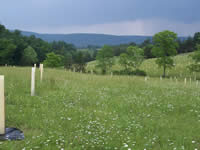
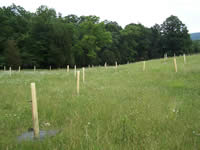
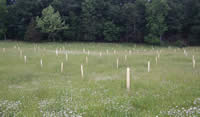
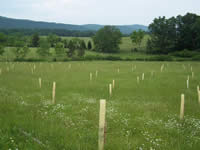
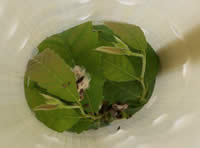
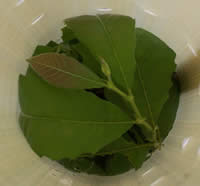
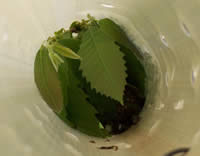
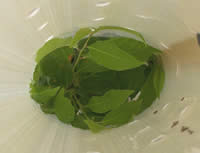
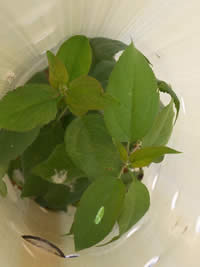
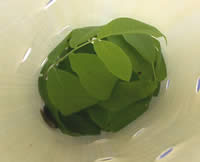
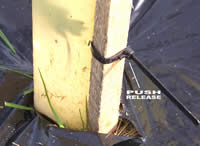
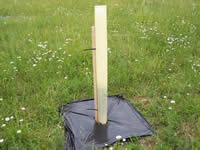
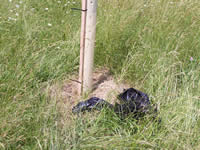
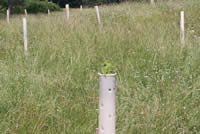
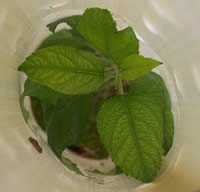
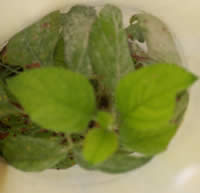
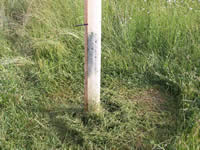

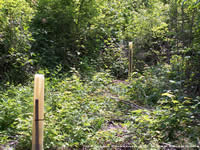
| Home | Products | Company | |
| Caswell
Forest Products LLC 8596 Fort Valley Road Fort Valley, VA 22652 © 2006 Caswell Forest Products |
|